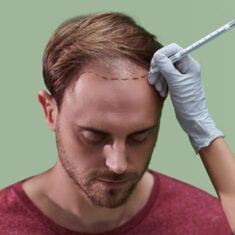Hair loss is nothing new. What has changed is how much power you have to combat it.
Over the past decade, medical breakthroughs have rewritten the story when it comes to balding. If you’re one of the vast majority of men who will experience hair loss in their lifetime, there are now a range of long-established, tried and tested methods for taking action – backed by science so you know you can trust them.
But anyone researching these solutions will likely come to the conclusion that there are two distinct paths: get a hair transplant, or start taking hair loss medication. But which one to pick? Well, the simple answer is: both.
Here’s why…
Why get a hair transplant?
Since arriving on the scene in the 1950s, hair transplant procedures have been steadily evolving, becoming increasingly sophisticated, effective and reasonably-priced. They are now so advanced that, in the right hands, it would take a medical expert to know whether or not you’d had one. For the average lay person, even a barber, a hair transplant should be impossible to spot.
So how do they work?
A hair transplant is a minimally invasive surgical procedure. Hair follicles are removed from a “donor area” of the scalp where hair still grows naturally, and re-inserted into the balding part of the head. The transplanted hair contains different DNA, so won’t fall-out over time, unlike the hair it’s replacing.
Over time – and with the right aftercare – the transplanted hair will grow naturally in its place.
What’s the point of medications?
While a hair transplant does the heavy lifting of moving healthy follicles into the areas that need them, you still need to promote growth. That’s where hair loss medications step in…
–By taking medically-approved hair loss solutions, you maximise the potential of your hair follicles full stop, giving you healthier, thicker hair growth.
–This is a good idea before your surgery, as it gives your surgeon more hair to work with.
–It’s also great after, as it promotes regrowth, and helps maintain your new, natural locks.
Which medications support regrowth best?
When it comes to hair loss treatments, there are only two names you need to know: Finasteride and Minoxidil. Not only are these medications incredibly popular, but they’re also tried and tested – backed by countless studies and approved by medical bodies around the world. They can be taken in topical or oral form – lotion or pills, that is – and when used together, studies have shown a whopping 9 in 10 men who experience hair loss find them beneficial.
Finasteride lowers the levels of the hormone that causes Male Pattern Baldness – the most common cause of hair loss in men. This allows your hair follicles to get back to growing hair.
Minoxidil works a little differently to Finasteride but works towards the same goal. Rather than blocking anything, it widens the blood vessels in the scalp, allowing them to carry more oxygen and nutrients to the affected areas.
Which should I take?
When used together, Finasteride and Minoxidil are a dream team, giving your hair follicles the support they need to grow thicker, healthier hair within 3-6 months. If you book a hair transplant through Manual, we’ll guide you through the process of finding a treatment plan that will work best for you – before and after surgery.
When should I start taking medications?
The easy answer to this question is… now! Finasteride and Minoxidil offer hair growth support that will benefit you whether you’ve had a hair transplant or not.
Here’s how they work with a transplant…
–Once you’ve decided that a hair transplant is the thing for you, most clinics will recommend that you take medications alongside your procedure.
–Beforehand, to help promote healthier growth within months, then afterwards to protect your hair transplant gains and increase hair density.
–You’ll take a short break of a few weeks around your actual surgery date, but most clinics suggest restarting medications two weeks after the transplant is complete.
–From here it’s advisable to continue taking them for the long-term, enjoying fuller, natural hair growth that lasts.
What would exclude me from taking medications?
Finasteride and Minoxidil offer the best, medically-backed solution for promoting hair growth. They are hugely popular medications and while some studies have identified a handful of side-effects, these cases are incredibly rare. For most people, these medications are safe and effective.
There are some specific exclusions that might mean these treatments aren’t for you. These include…
–Your age. You need to be over 18 to take Finasteride, and between 18 and 65 to take Minoxidil.
–Existing scalp problems
–Breast/prostate cancer
–Ongoing prostate monitoring
–Uncontrolled low or high blood pressure
If you’re not sure if these apply to you, don’t worry. That’s something we’ll talk through with you at Manual during your consultations.
What would exclude me from getting a transplant?
There are some obvious reasons why you might be feeling trepidation towards a hair transplant. How much will it cost? Will it hurt? Will it work? These are all valid concerns, but we’d be pleased to put your mind at rest.
Cost: Hair transplant costs vary, depending on where in the world you get one – Turkey, for example, offers a much lower-cost alternative to the UK – and many clinics offer financing options to support your purchase.
Trust: At Manual, we’ve only partnered with clinics we know and trust, both in Britain and abroad. So if you book through us, you know you’ll get a quality surgeon, whatever the cost.
Pain: Yes a hair transplant is an operation, but crucially it’s minimally invasive, and at most clinics is carried out under local anesthetic. Your clinic will talk to you about any specific health concerns you might have long before the procedure.
Results: It’s important to remember that modern hair transplants are an established, regulated form of surgery. They are tried and tested procedures that combine cutting edge medical science, with a simple logic that helps your body do what it does best. After all, you’re replacing your hair with… your hair! What could look more natural than that?
So, why would I do both again?
A hair transplant offers something no medication can: growth in previously bald areas. But it takes the support of medications like Finasteride and Minoxidil to support and promote that growth, ensuring your transplant is a solution that lasts.
Hair loss solutions that combine transplants and medication can be transformative. It’s the ultimate combination against hair loss, offering you control over your hairline and healthier growth. Side-effects may include increased confidence and a loss of interest in hats.









